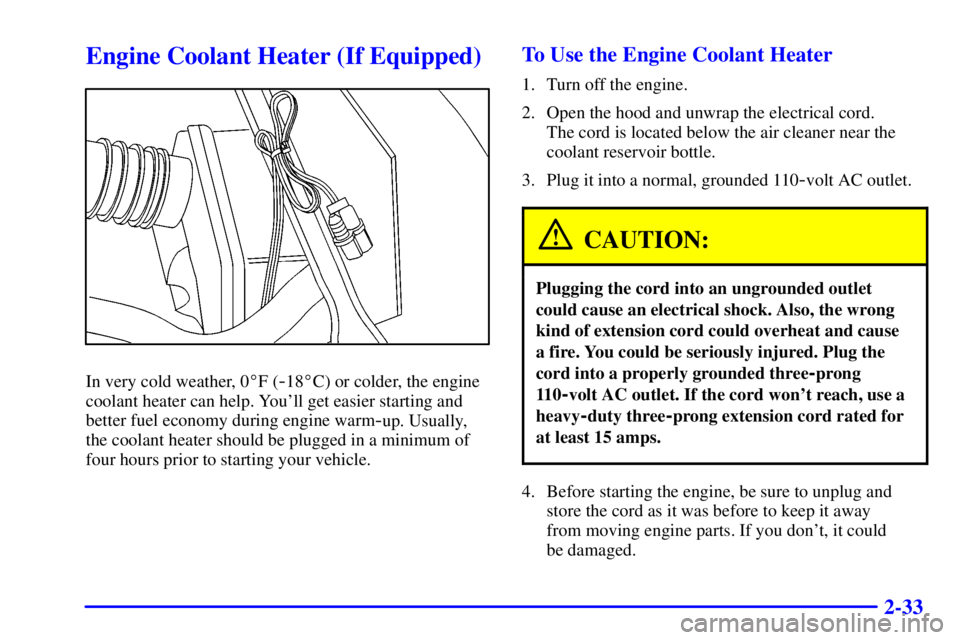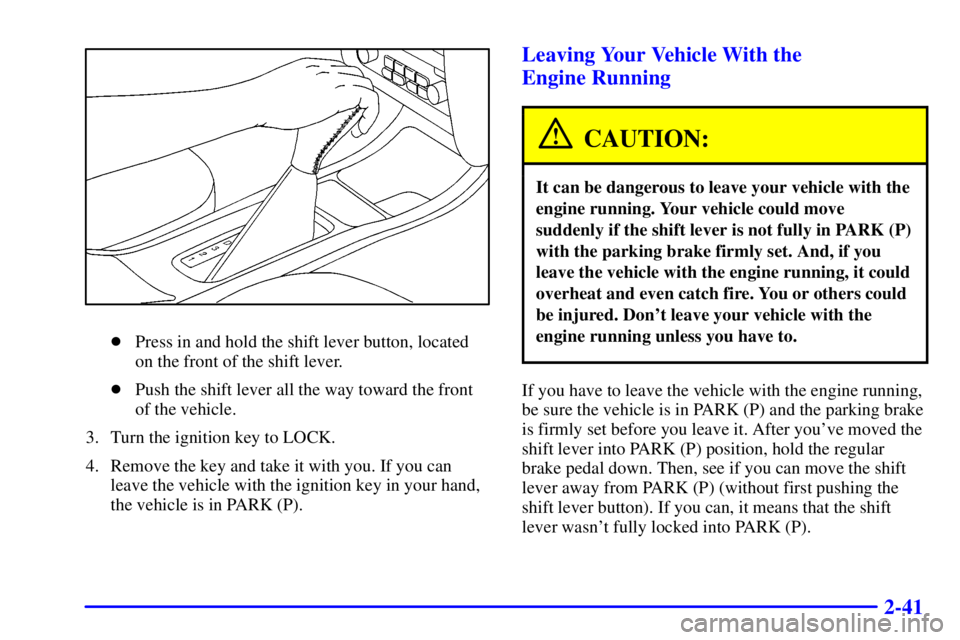Page 5 of 376
Table of Contents (cont'd)
Defensive Driving
Drunken Driving
Conrol of a Vehicle
Braking
SteeringDriving Tips for Various Road Conditions
Recreational Vehicle Towing
Loading Your Vehicle
Towing a Trailer Heating and Air Conditioning
Setting the Radio Clock
Radio/Cassette Player/CD PlayerRadio Theft-Deterrent Feature
Steering Wheel Controls (If Equipped)
Hazard Warning Flashers
Jump Starting
Towing Your VehicleEngine Overheating
Changing a Flat Tire
If You're Stuck
Problems on the Road
Section
3
Section
4
Section
5
Your Driving and the Road Comfort Controls and Audio Systems
iii
Page 101 of 376

2-33
Engine Coolant Heater (If Equipped)
In very cold weather, 0�F (-18�C) or colder, the engine
coolant heater can help. You'll get easier starting and
better fuel economy during engine warm
-up. Usually,
the coolant heater should be plugged in a minimum of
four hours prior to starting your vehicle.
To Use the Engine Coolant Heater
1. Turn off the engine.
2. Open the hood and unwrap the electrical cord.
The cord is located below the air cleaner near the
coolant reservoir bottle.
3. Plug it into a normal, grounded 110
-volt AC outlet.
CAUTION:
Plugging the cord into an ungrounded outlet
could cause an electrical shock. Also, the wrong
kind of extension cord could overheat and cause
a fire. You could be seriously injured. Plug the
cord into a properly grounded three
-prong
11 0
-volt AC outlet. If the cord won't reach, use a
heavy
-duty three-prong extension cord rated for
at least 15 amps.
4. Before starting the engine, be sure to unplug and
store the cord as it was before to keep it away
from moving engine parts. If you don't, it could
be damaged.
Page 105 of 376

2-37
FIRST (1): This position gives you even more power,
but lower fuel economy than SECOND (2). You can use
it on very steep hills, or in deep snow or mud. If the shift
lever is put in FIRST (1), the transaxle won't shift into
first gear until the vehicle is going slowly enough.
NOTICE:
If the front wheels can't turn, don't try to drive.
This might happen if you were stuck in very deep
sand or mud or were up against a solid object.
You could damage the transaxle.
Also, if you stop when going uphill, don't hold the
vehicle there with only the accelerator pedal. This
could overheat and damage the transaxle. Use the
brakes or shift into PARK (P) to hold the vehicle
in position on a hill.
Performance Shifting (If Equipped)
Press the performance shift
button, located on the side
of the console shift lever, to
allow the transaxle to shift
at higher engine speeds,
increasing firmness and
acceleration performance.
If you have a vehicle with the 3800 Supercharged
engine option, the PERFORMANCE SHIFT message in
the Driver Information Center (DIC) will come on.
Downshifts will occur at a lower percentage of
accelerator use while you're in the performance
shift mode.
Press the button again to return to normal shifting.
The transaxle will then shift at lower engine speeds,
increasing fuel economy.
Page 108 of 376
2-40
NOTICE:
Driving with the parking brake on can cause the
rear brakes to overheat. You may have to replace
them, and you could also damage other parts of
the vehicle.
If you are towing a trailer and parking on a hill, see
ªTowing a Trailerº in the Index. That section shows
what to do first to keep the trailer from moving.
Shifting Into PARK (P)
CAUTION:
It can be dangerous to get out of your vehicle if
the shift lever is not fully in PARK (P) with the
parking brake firmly set. Your vehicle can roll.
If you have left the engine running, the vehicle
can move suddenly. You or others could be
injured. To be sure your vehicle won't move, even
when you're on fairly level ground, use the steps
that follow. If you're pulling a trailer, see
ªTowing a Trailerº in the Index.
1. Hold the brake pedal down with your right foot and
set the parking brake.
2. Move the shift lever into PARK (P) position
like this:
Page 109 of 376

2-41
�Press in and hold the shift lever button, located
on the front of the shift lever.
�Push the shift lever all the way toward the front
of the vehicle.
3. Turn the ignition key to LOCK.
4. Remove the key and take it with you. If you can
leave the vehicle with the ignition key in your hand,
the vehicle is in PARK (P).
Leaving Your Vehicle With the
Engine Running
CAUTION:
It can be dangerous to leave your vehicle with the
engine running. Your vehicle could move
suddenly if the shift lever is not fully in PARK (P)
with the parking brake firmly set. And, if you
leave the vehicle with the engine running, it could
overheat and even catch fire. You or others could
be injured. Don't leave your vehicle with the
engine running unless you have to.
If you have to leave the vehicle with the engine running,
be sure the vehicle is in PARK (P) and the parking brake
is firmly set before you leave it. After you've moved the
shift lever into PARK (P) position, hold the regular
brake pedal down. Then, see if you can move the shift
lever away from PARK (P) (without first pushing the
shift lever button). If you can, it means that the shift
lever wasn't fully locked into PARK (P).
Page 142 of 376

2-74 Traction Control System Warning Light
(3800 Supercharged V6 Engine Only)
The traction control system warning light may come on
for the following reasons:
�If you turn the system off by pressing the TCS
button located on the far right side of the trip
computer, the warning light will come on and stay
on. To turn the system back on, press the button
again. The warning light should go off. (See
ªTraction Control Systemº in the Index
for more information.)
�If there's a brake system problem that is specifically
related to traction control, the traction control system
will turn off and the warning light will come on. If
your brakes begin to overheat, the traction control
system will turn off and the warning light will come
on until your brakes cool down.If the traction control system warning light comes on
and stays on for an extended period of time when the
system is turned on, your vehicle needs service.
Enhanced Traction System Warning Light
(3100 V6 or 3800 V6 Engine)
The Enhanced Traction System warning light may come
on for the following reasons:
�If you turn the system off by pressing the TRAC
button on the far right side of the Driver Information
Center or trip computer (if equipped), the warning
light will come on and stay on. To turn the system
back on, press the button again. The warning light
should go off. See ªEnhanced Traction Systemº in
the Index for more information.
Page 144 of 376
2-76 Engine Coolant Temperature Light
This light tells you that the
engine coolant has
overheated or the radiator
cooling fan is not working.
If you have been operating the vehicle under normal
driving conditions, you should pull off the road, stop the
vehicle and turn off the engine as soon as possible.
See ªEngine Overheatingº in the Index.
Engine Coolant Temperature Gage
United States Canada
You have a gage that shows the engine coolant
temperature. If the gage pointer moves into the red area,
the engine is too hot!
That reading means the same thing as the warning light.
It means that the engine coolant has overheated. If you
have been operating the vehicle under normal
conditions, you should pull off the road, stop the
vehicle, and turn off the engine as soon as possible.
See ªEngine Overheatingº in the Index.
Page 145 of 376
2-77 Low Coolant Warning Light
If this light comes on,
the system is low on
coolant and the engine
may overheat.
See ªEngine Coolantº in the Index and have the vehicle
serviced as soon as possible.
Malfunction Indicator Lamp
(Service Engine Soon Light)
United States Canada
Your vehicle is equipped with a computer which
monitors operation of the fuel, ignition and emission
control systems.
This system is called OBD II (On
-Board
Diagnostics
-Second Generation) and is intended to
assure that emissions are at acceptable levels for the
life of the vehicle, helping to produce a cleaner
environment. The SERVICE ENGINE SOON light
comes on to indicate that there is a problem and service
is required. Malfunctions often will be indicated by the
system before any problem is apparent. This may
prevent more serious damage to your vehicle. This
system is also designed to assist your service technician
in correctly diagnosing any malfunction.